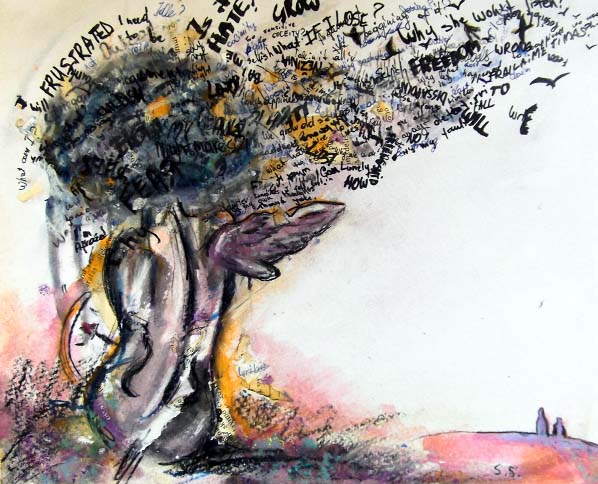
Life Desk :
Our mind is rarely at rest. It’s probably the most active and fertile part of our being. According to J Krishnamurti, “our life here is one of intense inner activity”. Events occur and give way to other happenings but the mind has the tendency to cling to it and ruminate at it like a cow whenever it is unoccupied.
It even anticipates horrific future events that may or may not occur. Such is the nature of the mind.
And yet, just as there is disparity in our physical being which is instantly evident, there is also disparity in our mental makeup (svabhava). These disparities however are not evident instantly but surface sporadically.
People can be classified into three categories on the basis of their mental makeup:
1. People who are die hard optimists. They have the capacity to turn a grave problem into an opportunity to learn and evolve. Even under the worst circumstances their stance is – “there must be some good in it.”
2. People who give the events and problems its due space and weightage. Such people are proactive and are good at dealing with consequences.
3. The third category of people turns even an inconsequential problem into a grave one. Such people have a very fragile ego and imagine an insult or affront in the behaviour of those around them easily. They are more of “revenge seekers” than problem solvers. People of this temperament are very difficult to deal with and this trait of theirs often makes them dysfunctional in their work and relationships.
The first category of people are said to be Satvik (deva/divine) in nature. The second category of people are said to be Rajsic (manushya/human) in nature, whereas the third category of people are Tamsic (rakshasa/demon) in nature.
Tamsic people perform actions (karma) solely as doers of action that is identified with the ego-self (ahamkara). They leave no room for the parallel reality (divine energy) to operate. They only reap the fruits of their actions in accordance with the working of universal energy (law of karma).
Rajsic people perform actions with a sense of responsibility, that is, by being aware of the consequences of their actions. They are aware of the working of universal energy and make an effort to perform good actions so that they can enjoy the fruits of their good actions.
Satvik people perform actions without identifying with their ego (ahamkara). They operate as instruments of divine energy (parallel reality) and leave the outcome of the actions that they perform to this parallel reality.
Hence the disparity that we see in our mental makeup is also the result of how we perform our karmas (actions).
Our karmas build our samskaars (innate mental tendencies). Just as we pass good physical characteristics through our genes to our progeny, we also pass on good “samskaars” to our future generations.
So, build on your “samskaars” because mental heredity is just as important, if not more, as physical heredity.
– Indian Express
Our mind is rarely at rest. It’s probably the most active and fertile part of our being. According to J Krishnamurti, “our life here is one of intense inner activity”. Events occur and give way to other happenings but the mind has the tendency to cling to it and ruminate at it like a cow whenever it is unoccupied.
It even anticipates horrific future events that may or may not occur. Such is the nature of the mind.
And yet, just as there is disparity in our physical being which is instantly evident, there is also disparity in our mental makeup (svabhava). These disparities however are not evident instantly but surface sporadically.
People can be classified into three categories on the basis of their mental makeup:
1. People who are die hard optimists. They have the capacity to turn a grave problem into an opportunity to learn and evolve. Even under the worst circumstances their stance is – “there must be some good in it.”
2. People who give the events and problems its due space and weightage. Such people are proactive and are good at dealing with consequences.
3. The third category of people turns even an inconsequential problem into a grave one. Such people have a very fragile ego and imagine an insult or affront in the behaviour of those around them easily. They are more of “revenge seekers” than problem solvers. People of this temperament are very difficult to deal with and this trait of theirs often makes them dysfunctional in their work and relationships.
The first category of people are said to be Satvik (deva/divine) in nature. The second category of people are said to be Rajsic (manushya/human) in nature, whereas the third category of people are Tamsic (rakshasa/demon) in nature.
Tamsic people perform actions (karma) solely as doers of action that is identified with the ego-self (ahamkara). They leave no room for the parallel reality (divine energy) to operate. They only reap the fruits of their actions in accordance with the working of universal energy (law of karma).
Rajsic people perform actions with a sense of responsibility, that is, by being aware of the consequences of their actions. They are aware of the working of universal energy and make an effort to perform good actions so that they can enjoy the fruits of their good actions.
Satvik people perform actions without identifying with their ego (ahamkara). They operate as instruments of divine energy (parallel reality) and leave the outcome of the actions that they perform to this parallel reality.
Hence the disparity that we see in our mental makeup is also the result of how we perform our karmas (actions).
Our karmas build our samskaars (innate mental tendencies). Just as we pass good physical characteristics through our genes to our progeny, we also pass on good “samskaars” to our future generations.
So, build on your “samskaars” because mental heredity is just as important, if not more, as physical heredity.
– Indian Express

